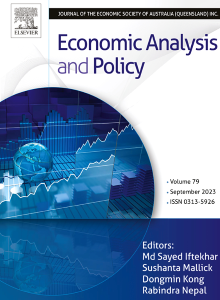How effective are emission taxes in reducing air pollution? A satellite-based case study for Spain
IF 7.9
2区 经济学
Q1 ECONOMICS
引用次数: 0
Abstract
Air pollution poses significant risks to public health and the environment. Policymakers aim to counteract these risks by implementing policies to reduce pollution and emissions. Emission taxes are a prominent market-based tool. However, their real-world effectiveness remains underexplored. This study evaluates the impact of an economically significant tax on nitrogen oxide (NOx) introduced in the Comunidad Valenciana in 2013 compared to the rest of Spain using a difference-in-differences framework. To measure the area-wide spatiotemporal changes in air pollution, the study leverages satellite-based NO2 data. The findings reveal that the emission tax achieved a modest 1.2 % decline in NO2 levels annually, equivalent to approximately 728 tons of NOx emissions. In a series of robustness tests, heterogeneity analysis highlights stronger reductions in industrial areas, innovative firms, and larger companies, emphasizing the role of technological capacity. In contrast, firms with significant market power tend to shift the tax burden to stakeholders instead, thereby reducing its environmental impact. These results suggest that emission taxes have an effect in the intended direction; however, the effect alone does not significantly curb NO2 pollution. Complementary measures, such as innovation incentives and stricter regulatory standards, are necessary to enhance their effectiveness. By providing granular evidence of emission taxes’ real-world impacts, this study offers valuable insights for policymakers designing targeted and efficient environmental policies.
排放税在减少空气污染方面的效果如何?基于卫星的西班牙案例研究
空气污染对公众健康和环境构成重大风险。决策者的目标是通过实施减少污染和排放的政策来抵消这些风险。排放税是一个重要的市场化工具。然而,它们在现实世界中的有效性仍未得到充分探索。本研究使用差异中的差异框架,评估了2013年瓦伦西亚自治区引入的氮氧化物(NOx)经济税与西班牙其他地区的影响。为了测量空气污染在整个区域的时空变化,该研究利用了基于卫星的二氧化氮数据。研究结果显示,排放税每年使二氧化氮水平下降1.2%,相当于大约728吨氮氧化物排放量。在一系列稳健性检验中,异质性分析突出了工业地区、创新企业和大型企业的降幅更大,强调了技术能力的作用。相反,具有重要市场力量的公司倾向于将税收负担转移给利益相关者,从而减少其对环境的影响。这些结果表明,排放税在预期的方向上有影响;然而,单靠这种效果并不能显著抑制二氧化氮污染。有必要采取补充措施,如鼓励创新和更严格的监管标准,以提高其有效性。通过提供排放税对现实世界影响的详细证据,本研究为决策者设计有针对性和有效的环境政策提供了有价值的见解。
本文章由计算机程序翻译,如有差异,请以英文原文为准。
求助全文
约1分钟内获得全文
求助全文
来源期刊

Economic Analysis and Policy
ECONOMICS-
CiteScore
9.80
自引率
9.20%
发文量
231
审稿时长
93 days
期刊介绍:
Economic Analysis and Policy (established 1970) publishes articles from all branches of economics with a particular focus on research, theoretical and applied, which has strong policy relevance. The journal also publishes survey articles and empirical replications on key policy issues. Authors are expected to highlight the main insights in a non-technical introduction and in the conclusion.
 求助内容:
求助内容: 应助结果提醒方式:
应助结果提醒方式:


